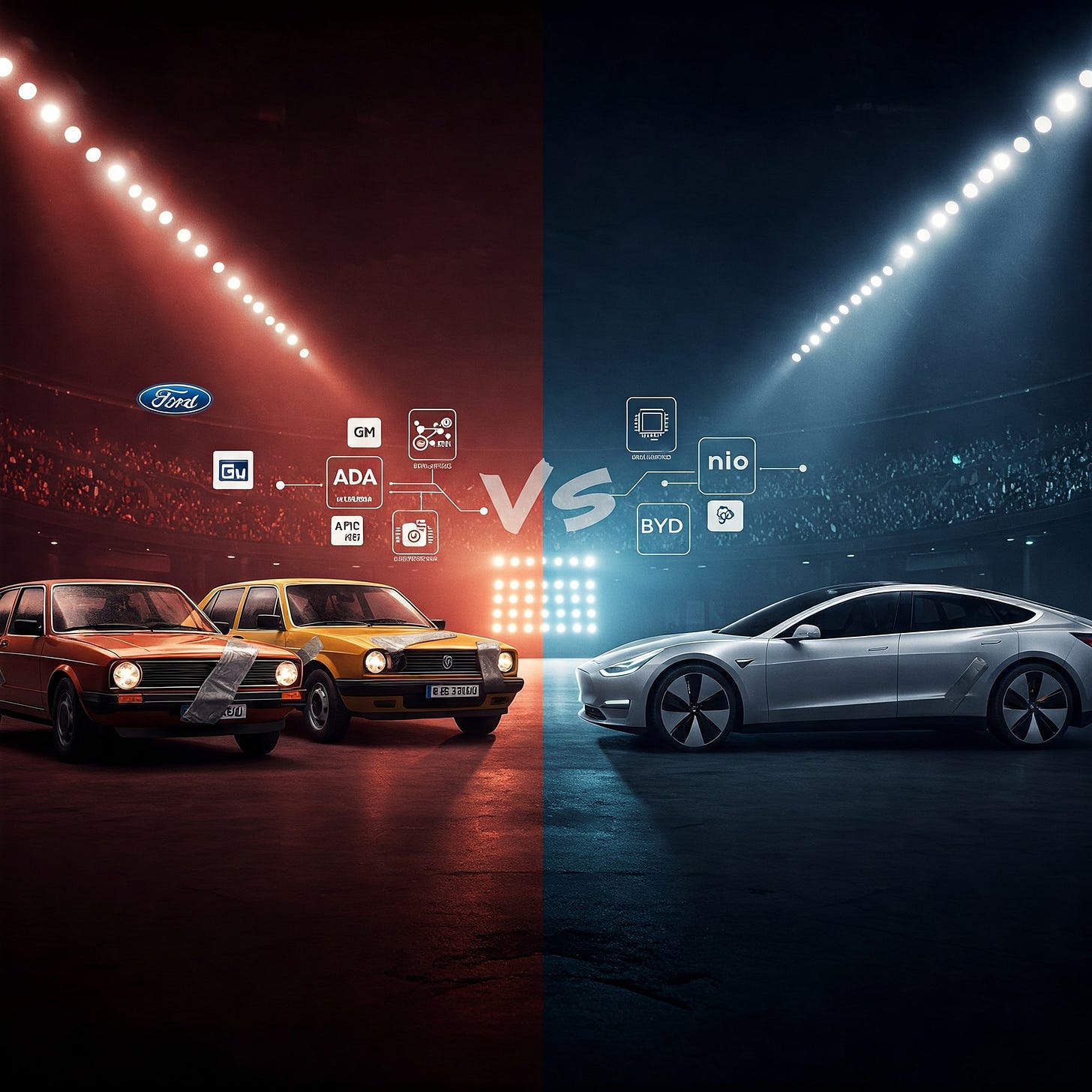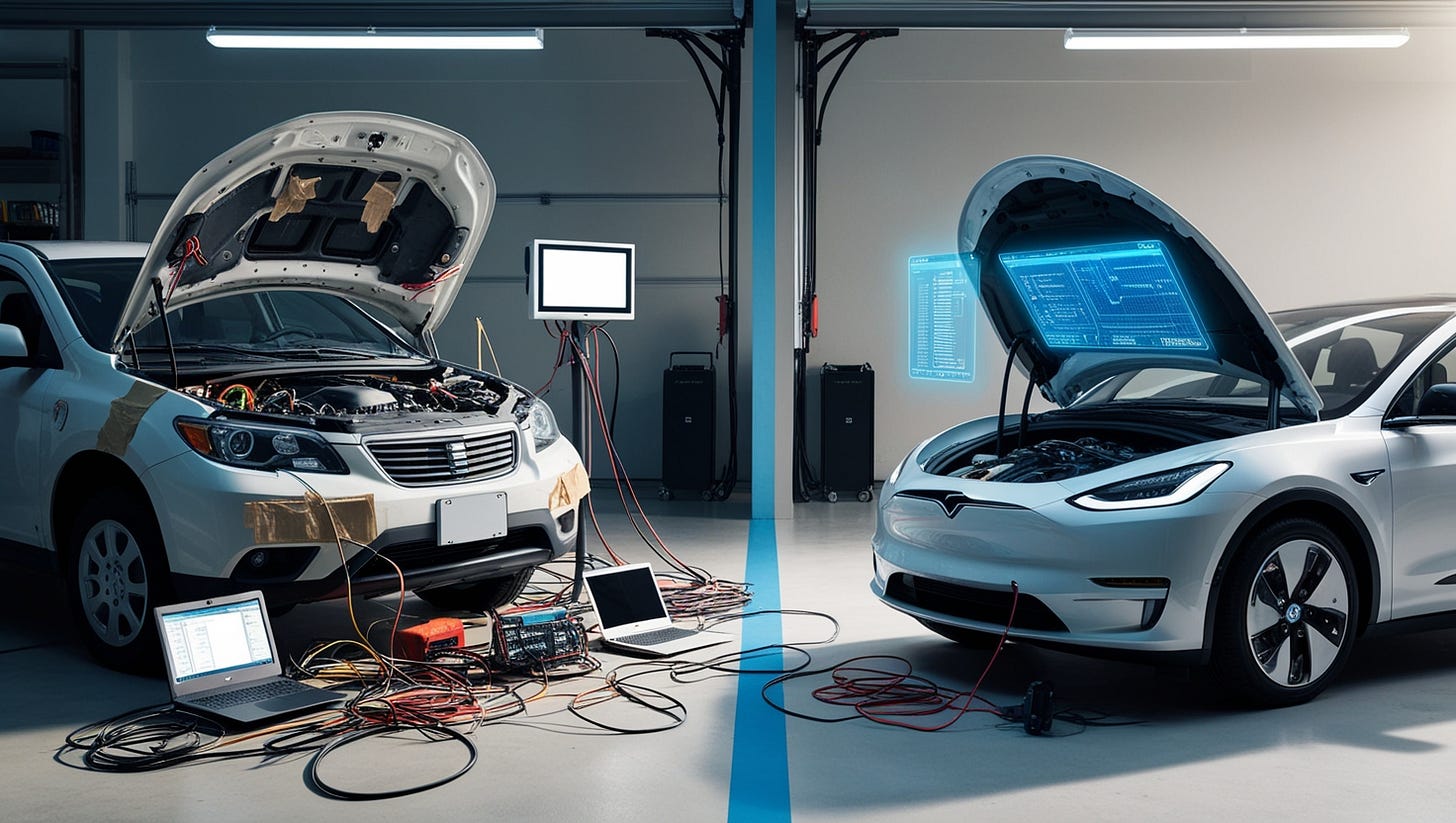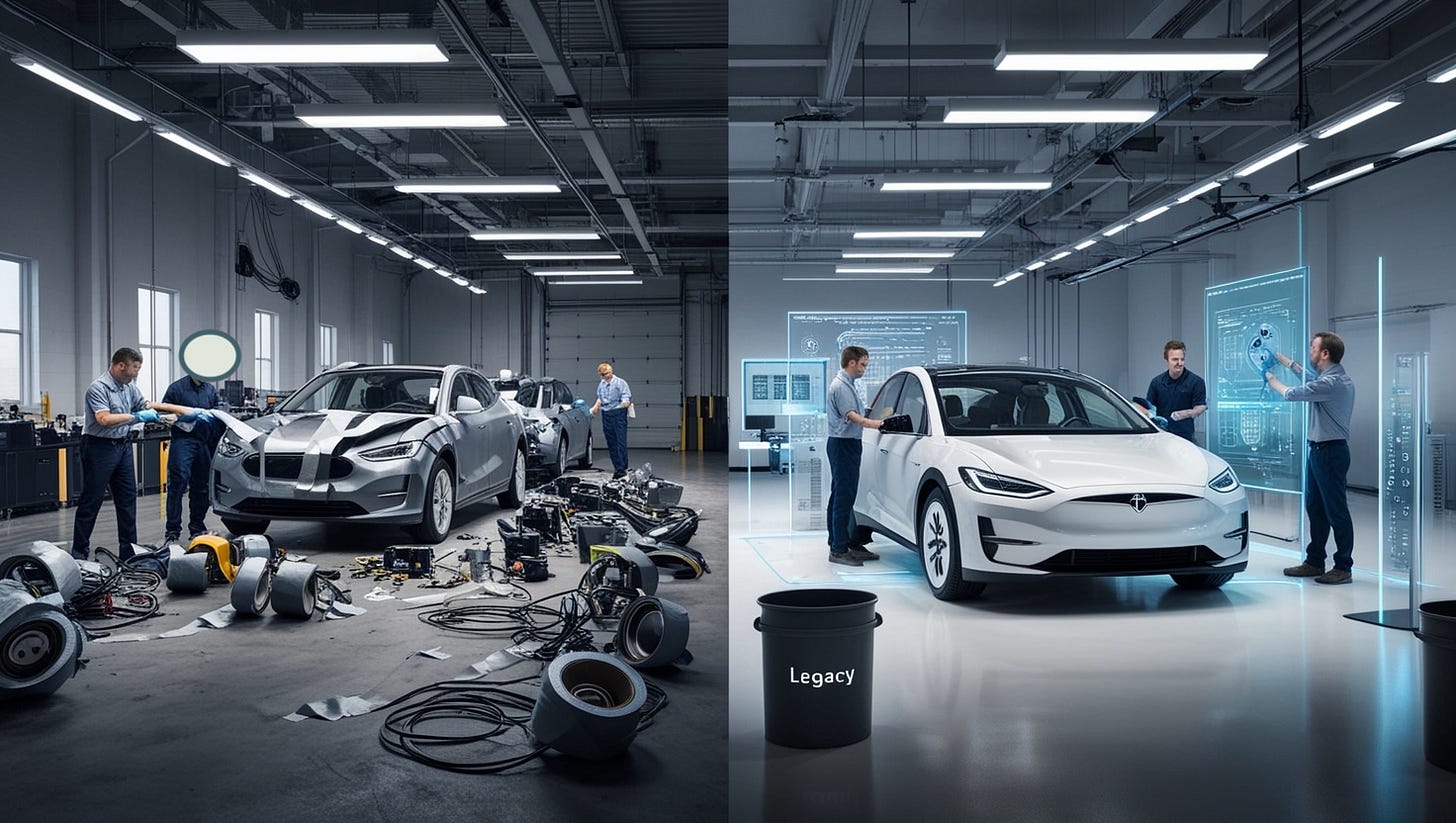Duct Taped SDVs of Legacy Car Makers
Explore how legacy car giants patch outdated systems to compete with software-first automakers like Tesla and NIO—uncover the cultural, technical, and leadership challenges fueling "duct taped" SDVs

1. Introduction
Software-defined vehicles (SDVs) are redefining how cars are designed, built, and upgraded. While hardware and mechanical components remain important in an SDV, the software determines critical capabilities—from infotainment and connectivity to advanced driver-assistance systems (ADAS) and autonomous functionalities. This software-centric approach allows vehicle manufacturers to deliver over-the-air (OTA) updates, quickly patch security vulnerabilities, and introduce new features without requiring a physical recall.
However, for legacy automakers such as Volkswagen, Nissan, Ford, GM, and Toyota—entities that have thrived on traditional mechanical engineering for decades—the shift to software-driven development has proven challenging. Their reliance on existing supply chains, siloed organizational structures, and outdated electronic/electrical (E/E) architectures often leads to a practice best described as “duct taping.” In essence, they layer new software features on top of ageing systems, introducing short-term fixes rather than genuinely rebuilding vehicles from the ground up.
Faced with formidable competition from Tesla, BYD, Rivian, NIO, and Xiaomi, these legacy Original Equipment Manufacturers (OEMs) must transform profoundly or risk losing their existence in a rapidly evolving market. Below, we explore their cultural, leadership, and technical challenges, as well as lessons from software-native players and the potential future of those who fail to adapt.2. The Traditional Mindset and Fear of Change
2.1 Hardware-First vs. Software-First Mentality
Historically, automakers have excelled at mechanical engineering. Their success metrics have revolved around producing durable, reliable vehicles at scale. Software was treated as peripheral—an add-on to enhance infotainment or basic engine control units (ECUs). However, modern vehicles depend on integrated, continuously updated software platforms.
Cultural Inertia: Deeply entrenched mechanical engineering expertise can overshadow the necessity for software innovation, stifling efforts to adopt contemporary software development lifecycles.
Fear of Experimentation: Unlike tech companies, which embrace rapid prototyping and iterative improvements (even if it means risking early bugs), legacy OEMs often fear that any software glitch could erode brand image.
2.2 Openness and Agile Culture
A culture of openness and agility is vital for software development. In Silicon Valley, for instance, teams expect to fail fast, learn, and pivot quickly. This approach is at odds with traditional automotive practices, which rely on multi-year development cycles.
Long Product Cycles vs. Rapid Iteration: Tesla can push a feature update over the air in a matter of weeks, whereas legacy OEMs typically lock in vehicle features years before launch.
Siloed Mindsets: Cross-disciplinary collaboration—software engineers working closely with mechanical and electrical teams—is often hampered by rigid departmental boundaries.
3. Leadership Challenges in Legacy OEMs
3.1 Lack of Technical Expertise at the Top
Many decision-makers in traditional automakers rose through ranks focused on mechanical engineering, manufacturing, or business administration. Software expertise is a relatively new requirement at the C-suite level, creating a leadership gap:
Strategic Blind Spots: Without deep software backgrounds, leaders may underinvest in critical capabilities like cloud computing, cybersecurity, and AI-driven systems.
Resource Allocation: Budgets could disproportionately favor physical infrastructure or legacy technologies over modern software platforms and developer tools.
3.2 Slow & Inflexible Decision-Making
Automotive giants often have hierarchical structures where decisions must be approved at multiple levels:
Bureaucratic Delays: Approvals for new software features or architectural changes can take months, slowing the pace at which innovative ideas reach customers.
Missed Market Opportunities: By the time an advanced feature rolls out, software-native rivals may have iterated two or three times, refining user experiences based on real-world data.
4. Agility Concerns: Rigid Processes & Siloed Departments
4.1 Legacy Organizational Structures
Legacy OEMs typically manage separate divisions for powertrain, body and chassis, and electrical systems. Software is often considered an add-on to these core domains. While this structure worked well for mechanical engineering, it hinders integration in an era where software needs to be seamlessly embedded from day one.
Complex Approval Chains: A software patch might require sign-offs from hardware, safety, legal, and branding teams.
Insufficient Collaboration: Without cross-functional communication, software teams may lack critical insights into mechanical or electrical constraints.
4.2 The Cost of Siloes
Siloes inhibit shared learning and collaboration across departments:
Duplicative Efforts: Different teams may develop overlapping software solutions, leading to inefficiency and inconsistent user experiences.
Delayed Time-to-Market: Every step in the production pipeline faces bottlenecks, resulting in extended development cycles that prevent swift responses to market demands.

5. Technical Debt: Fragmented Architectures & Vehicle E/E Systems
5.1 Legacy Systems and Codebases
Many legacy carmakers rely on vehicle architectures with numerous ECUs—sometimes exceeding 100 per vehicle—each running specialized software for functions like transmission control, infotainment, or ADAS.
Integration Hurdles: Getting these ECUs to communicate seamlessly and handle OTA updates is no small feat, especially when codebases were never designed for connected car features.
Maintenance & Security Risks: Patching old systems can introduce new bugs or vulnerabilities, creating a growing backlog of technical debt.
5.2 Patching vs. Ground-Up Redesign
Rather than fully redesigning vehicles around centralized computing, many OEMs “duct tape” new functionality onto legacy platforms:
Middleware Layers: Projects like Volkswagen’s Cariad or GM’s Ultifi attempt to unify disparate systems via a software layer, but it’s a workaround rather than a true rebuild.
Performance Bottlenecks: Extra software layers can cause latency and degrade the real-time performance required for advanced autonomy or complex driver-assistance functions.
5.3 Overlooking Developer Experience
Legacy OEMs may focus on adding feature after feature (increasing lines of code) without investing in developer tooling, testing automation, and code quality:
Complex Toolchains: A lack of modern DevOps practices slows down release cycles and reduces code quality.
Talent Retention: Skilled software engineers often prefer companies with streamlined processes and modern tech stacks, making legacy OEMs less attractive to employers.

6. The Need for a Paradigm Shift: Ditching the Duct Tape
6.1 Lessons from Tesla, Rivian, BYD, Xiaomi, and Others
Centralized Computing: Tesla’s decision to house most vehicle intelligence on a central processing unit means simpler integration of new features.
OTA as a Core Capability: Rivian and Tesla demonstrate that continuous, seamless updates can delight users and refine vehicle performance.
Vertical Integration: BYD’s approach (from batteries to in-house software) reduces supplier dependency and accelerates innovation.
Rapid Iteration: Startups like NIO and Xiaomi rely on agile frameworks, enabling them to pivot faster than their legacy counterparts.
6.2 What Legacy OEMs Must Do to Truly Transition
Organizational Redesign: Break down siloes, merge hardware and software teams, and adopt a product-focused rather than function-focused structure.
Leadership Overhaul: Appoint leaders with strong software backgrounds, giving them the autonomy and budget to drive transformation.
Invest in Centralized E/E Architectures: Embrace zonal architectures or single powerful CPUs to unify and simplify vehicle systems.
Prioritize Developer Experience: Adopt modern DevOps practices, code quality checks, and agile workflows. This not only accelerates feature releases but attracts top engineering talent.
7. Conclusion: Who Will Survive the Transition?
7.1 Duct Tape vs. True Transformation
The metaphor of “duct taping” highlights how legacy OEMs are glueing new software elements onto outdated systems in an attempt to keep pace. While it may offer short-term fixes, it fails to address the root cause: a foundational mismatch between hardware-centric designs and the demands of modern software.
7.2 Market Dynamics and Potential Consolidation
As consumers increasingly value software capabilities—smart cockpit features, ADAS, and OTA updates—automakers that cannot pivot may lose market share to software-native rivals. Some possible outcomes:
Consolidations: Struggling OEMs might merge to pool resources, or tech giants could acquire iconic brands for their manufacturing capabilities.
Niche Survival: Certain legacy automakers might carve out specialized niches, focusing on performance or luxury while outsourcing critical software components.
7.3 Final Thoughts
The software will ultimately redefine the automotive world. While mechanical excellence remains crucial, it is no longer sufficient for leadership in a connected, autonomous future. Those who abandon duct tape fixes and embrace a ground-up, software-first paradigm stand the best chance of thriving.
8. References
Volkswagen's Software Delays and Leadership Changes
GM's Ultifi Platform
GM reveals 'Ultifi' platform in bid to become leader in software-led vehicles. CNBC, September 30, 2021. Link
Toyota's Investments in AI and Software
McKinsey on the Future of Automotive Software
Tesla's Software-Defined Approach
NIO's Advancements in Self-Driving Technology
Rivian's Software Strategy
2025 Rivian R1T Concentrates on Inner Beauty. Car and Driver, June 15, 2024. Link
BYD's Integrated Battery-EV Approach
When Will America Get Its $25,000 Electric Car?. Bloomberg, June 17, 2024. Link
This blog is edited and enhanced with ChatGPT o1 & 4o.
Video Generated by OpenAI Sora, Image Generated by Leonardo.ai


